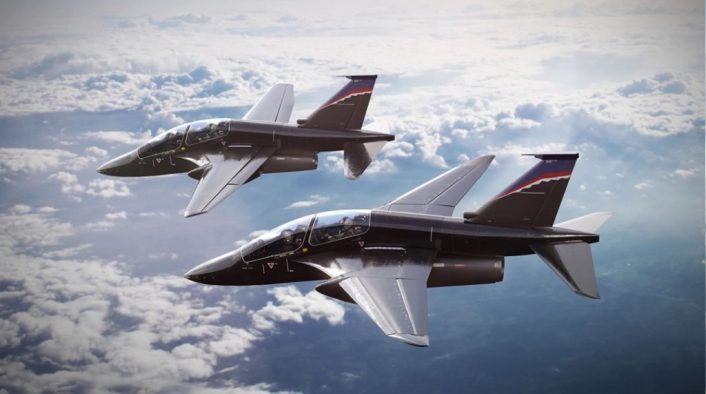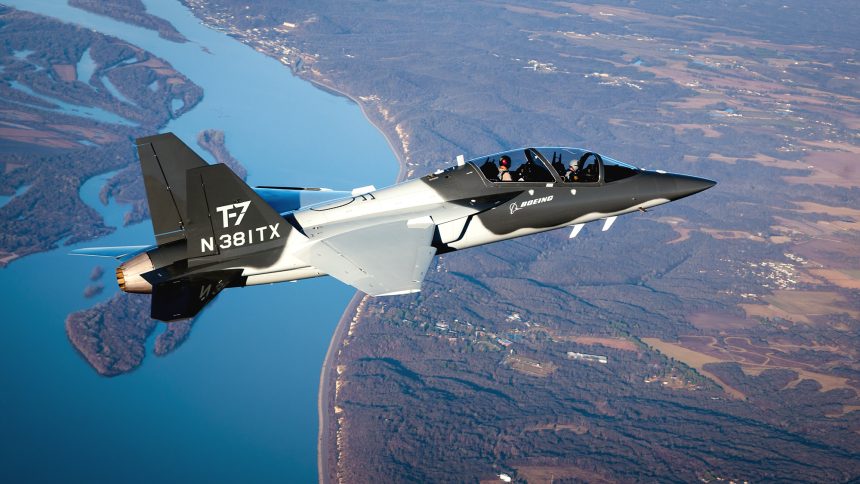Ahead of an expected competition to replace the RAF’s Hawk T2s, Saab, Boeing, and BAE Systems have signed a letter of intent to collaborate on a pilot training system centered on the T-7 Red Hawk.
In a press release published on Nov. 18, 2025, the Vice President of Boeing Defense, Space & Security’s Business Development & Strategy, Bernd Peters, said “Together, Boeing with Saab and now BAE Systems will offer innovative training solutions to best prepare RAF pilots for the future, including advanced fourth-, fifth- and sixth-generation fighters.”
He added that “This collaboration enhances the best of our technological capabilities, strengthens the transatlantic industrial base and offers opportunities for cooperative development.”
Boeing and Saab have jointly produced the T-7 Red Hawk as a replacement for the U.S. Air Force’s long-serving T-38 Talon. The T-7 is a single-engine jet trainer which made its maiden flight (as the Boeing T-X) in 2016, with the first unit delivered to the USAF in 2023. Unlike the T-38, the T-7 is not designed for supersonic flight, but can achieve transonic speeds up to Mach 0.975 using an afterburning General Electric F404 turbofan. Initial operating capability is slated for 2027, despite a decision to delay the aircraft’s production phase.
The requirement for a new Royal Air Force jet trainer has slowly emerged over the last few years, with the then Chief of the Air Staff (now Chief of the Defence Staff) Sir Rich Knighton expressing a desire to replace the Hawk T2 as soon as possible. Originally scheduled to retire in 2040, the Hawk T2 has been plagued by availability issues stemming from engine reliability. Knighton said the air force only gets “half of what we should get” from the aircraft. Additionally, the RAF’s remaining fleet of Hawk T1 aircraft, which serve exclusively with the Royal Air Force Aerobatic Team, or the Red Arrows, are due to be withdrawn in 2030.

Finally, the requirement was committed to paper in the 2025 Strategic Defence Review, which called for a new “cost-effective jet trainer”. A subsequent statement from a defence minister confirmed that both the Hawk T1 and T2 were under consideration to be replaced with this new yet to be determined aircraft type.
Initially seeming to be a less attractive option due to the lack of UK involvement in the programme, the inclusion of BAE Systems within the consortium breathes new life into the concept of T-7s for the RAF. BAE Systems, in its various historical guises, was responsible for the design and production of the Hawk aircraft. Despite current issues, the Hawk has ably served the UK’s armed forces as a jet trainer, aggressor, and even briefly an air defence aircraft, for almost fifty years – and by the time of its withdrawal the Hawk T1 will have surpassed that milestone.
We are collaborating with @BoeingDefense and @Saab on a next generation pilot training system based on the T-7 trainer aircraft.
Initially this work will focus on responding to the UK @RoyalAirForce’s requirement for a future trainer aircraft.https://t.co/LKAYDe8OcB pic.twitter.com/dbJ6dzqoCP
— BAE Systems Air (@BAESystemsAir) November 18, 2025
“Our new collaboration with Boeing and Saab will enable us to present a compelling offer to the UK Royal Air Force and our global customers, leveraging the latest tech innovation in training systems and a world-class jet trainer aircraft,” said Simon Barnes, Group Managing Director of BAE Systems’ Air sector. “We’re committed to ensuring this solution offers the best overall outcome for the nation to support the UK’s combat air readiness and deliver economic benefit.”
Strong Competition
BAE Systems’ plant at Warton Airfield, home to final assembly lines for the Eurofighter Typhoon and the Hawk, is likely to be a focus for the British company’s participation in the project – which is confirmed to include UK-based final assembly. With no further orders for the Hawk in place, the production line can be redeveloped for the T-7 and allow for the RAF’s training aircraft to be British-built, even if not British-designed. This is an important factor to consider, especially while Aeralis – a UK firm which has received funding from the Ministry of Defence but has yet to produce a prototype of its novel modular jet aircraft – has struck deals for a final assembly line at Glasgow Prestwick Airport should they receive orders.

Other expected bids include the Turkish Hürjet as well as Leonardo’s M-345 and/or M-346. UK Prime Minister Sir Keir Starmer was shown an example of the Hürjet while touring a Turkish Aerospace Industries (TAI) plant last month, where it was announced that Turkey is to buy 20 Typhoons through the UK in a contract worth £8 billion. This order heightened expectations that a collaboration between BAE Systems, as a major partner in the Eurofighter consortium, could team up with TAI for a reciprocal order of Hürjets for the UK and provide a British final assembly line. This now, clearly, seems unlikely to come to fruition, and leaves TAI with few options available for a UK partnership.
Leonardo have their own UK facility at Yeovil, though this is tailored for rotary wing aircraft and has only a grass runway. Plans have been afoot for a hard surface runway to be laid for several years, though even if this does occur the runway is still limited in its length at just under 4,000 feet. Theoretically, though, this could still permit completed, high performance fixed wing aircraft like a jet trainer to take-off from the field and reposition elsewhere – like the nearby MoD Boscombe Down – for further trials and testing. Leonardo have previously confirmed that the company would consider UK-based final assembly as part of its proposal.
@Leonardo_live offers UK final assembly of M-346 as Hawk replacement need grows. From interview today at DSEI show in London. The @RoyalAirForce future AJT and Red Arrows successor contest – yet to launch – is already great to cover! https://t.co/UFA7UmANQP pic.twitter.com/hAX578JjTJ
— Craig Hoyle (@FlightAcesHigh) September 10, 2025
Italy, the primary user of the M-345 and M-346, is due to have a future fighter fleet essentially identical to the UK’s – featuring Typhoons, F-35As, F-35Bs, and eventually the aircraft that results from the Global Combat Air Programme (GCAP). As such there is significant overlap in the two nations’ requirements for fast jet training and this is fertile ground for further close collaboration between the Royal Air Force and Italian Air Force. RAF pilots have already completed training courses using the M-346 at Decimomannu Air Base and will almost certainly be called upon for feedback as the RAF considers its options over the next several years.









